
Quiet Quitting
Harness the power of employee-led L&D to combat 'quiet quitting'
The talent landscape is undergoing a seismic shift as organisations grapple with the aftermath of the Great Resignation. In an era where employee engagement has become the holy grail, we saw the emergence of quiet quitting. Coined by Brian Creely in 2022, the term relates to employees who only work to the job description. They don't go 'above and beyond', and won't put in even the slightest extra effort or time into their work above what's set out in the job spec.
Inspired by the shifting workplace attitudes and expectations post-pandemic, employees now favour remote and hybrid working. They're driven by a desire of greater work-life balance. A recent AT&T study found the hybrid work model is expected to grow from 42% in 2021 to 81% in 2024. Quiet quitting for many represents a disengagement from working life, and a drop in productivity and efficiency.
So how much of a problem is quiet quitting, and how can businesses address the trend?

Impact of quiet quitting on worker attitudes
To understand the post-pandemic trends in relation to training, we partnered with independent survey company Research Without Barriers. Finding out employee attitudes to training in 2023 gave us a clearer picture of the wider issue of employee disengagement in the workplace.
We surveyed 2,000 UK workers, split between 1,000 managers and 1,000 non-managerial employees. The surveyed managers have over 15 years of work experience and work in companies of more than 15 employees. The surveyed non-managerial employees have a maximum of three years of experience, and work in companies with more than 15 employees. The goal of these sample requirements was to give us better insight into the attitudes held at different levels of seniority. In the context of a rise in quiet quitting, the results were surprising – and promising.
Is 'quiet quitting' impacting wider employee engagement?
A common belief about quiet quitting is that employees are disengaging because they don't want to work hard or build careers. Our research actually suggests that there remains a strong desire for personal and professional growth among the UK workforce.
A staggering 86% of respondents expressed a willingness to stay longer with their employer – if the employer offers more L&D opportunities. Employees also aren't necessarily interested solely for what a company offers them. Almost all (94%) believed that the company would also benefit if they were given more training. In other words, workers are still willing and interested in engaging with their employers, supporting business goals, and building careers. But they are seeking fulfilment and a mutually beneficial relationship with their employer. This conclusion is reinforced by the social shifts we saw with the Great Resignation, where workers sought work that enhanced their lives.
Our findings underscore the pivotal role that learning & development plays in engaging employees. It provides them with fulfilling work lives – directly impacting their engagement with their roles and countering quiet quitting.
Managerial involvement in training
Managers play a crucial role in nurturing a culture of learning and development within their teams. The survey results revealed that 59% of managers recognise the importance of training in keeping employees engaged and motivated in their roles. In fact, 78% of managers also acknowledged that training had a positive impact on their own commitment and engagement. Generally, business leaders are aware that learning and development have a direct impact on employee engagement at all levels. Understanding this gives us a tool to address quiet quitting within an organisation – where employees are willing and able.

How to deliver employee-led L&D
Despite the awareness, many organisations are falling short in leveraging learning and development as a tool for employee engagement, retention and skills enhancement. Only 29% of managers actively involve employees in selecting and integrating training programmes for their professional development. And 42% of employees reported having no active involvement in training beyond participation. This suggests that many employers, while aware of the benefits of training, are missing out on the benefits that come from actively involving workers in their own development.
There are simple ways to harness the benefits of employee-driven learning and development. These include giving employees personal ownership of training through suggesting courses or subjects and assisting with the sourcing of learning content. But it may also extend to involving employees in learning KPIs or the development of learning pathways.
Russell Donders, Director of International Markets at imc Learning, notes that "we have worked closely with businesses to offer bespoke training and development pathways for a range of industries. Feedback from customers, and our research, is clear: training is a key contributor to employee engagement and business development. Each of us wants to fulfil our potential, and we see huge success in the businesses who understand how to implement that on a personal level.
Bespoke training packages, rolled out across all levels of operation, is a simple and effective tool to engage and retain talent. It even feeds into the recruitment process. In fact, 92 percent of job seekers now consider L&D opportunities to be a dealbreaker – so it makes sense this would also feed into engagement for existing talent. Empowering individual-driven learning and development pathways is a simple but effective solution to address changing priorities and reverse, or avoid, quiet quitting."
Quiet quitting can be addressed by employee-led L&D
Employee engagement has become of paramount importance given the challenges around talent scarcity. The trend of quiet quitting highlights the significance that employee satisfaction and fulfilment now play in modern-day workplaces. Businesses that are responsive to that will see real benefit to productivity and talent retention. By embracing employee-driven learning and development, organisations can align themselves with the evolving needs of their employees. The aim is to enhance retention rates and create a positive, growth-centred workplace in which productivity is a natural consequence of the environment.
Looking to implement an employee-led L&D programme?
We'd love to hear how your organisation aims to increase loyalty and engagement through employee-led L&D. Get in touch with us to see how imc can help you best reach your strategic goals.

When an Awareness Week Is Not Enough – Engaged Learning Through Learning Campaigns
Using learning campaign portals to create immersive learning campaigns
Some things just can’t be learned in an hour. Or even a week. Things like organisational change management – where attention needs to be focused on a specific topic over a prolonged period. In these cases, sustained learning is key.
It’s a little bit like classic advertising. Coca-Cola’s annual advertising presence, for example, doesn’t hinge on a single one-week TV spot campaign. Instead, the company draws attention to its products over a sustained period using a strong, well-coordinated multi-channel campaign. It’s all carefully designed to ensure consumers reach for the red can the next time they open the chiller.
In the same way, a good learning campaign should bring about a mind shift – ideally one that leads to concrete action. Sounds good, but how exactly? The answer is portals. They can provide a highly effective entry point to learning campaigns. In this article, we outline the structure and use of learning campaign portals.

Immersive user interfaces for specific topics
With organisation-wide learning and development (L&D) campaigns, the idea is to reach as many employees as possible. And for that, the content must be both learner-centric and accessible without any time or location constraints. Most importantly, it must boost learning motivation and generate successful, lasting learning outcomes.
These objectives can be achieved by using a learning campaign portal. Learning campaign portals are add-ons for learning management systems. They facilitate orientation in complex learning campaigns, providing learning environments that are so immersive, learners don’t even realise they’re learning.

These interactive learning environments are custom developed for each client and brand. Learners can make their own way through the navigation structure and access different items of learning content through jump labels. The result is a digital journey of discovery that is almost limitless in scope. Chatbots, avatars, and dynamic environmental and special-effect sounds can be integrated to reinforce sustained learning effectiveness. Similarly, gamification elements can be added to further enhance learner motivation.
Some applications of learning campaign portals
- Change campaigns: Change campaigns are a way of making lasting change to employee mindsets and corporate culture. The objective is to boost acceptance through learning. That way, employees are more amenable to the proposed changes and more willing to contribute to their success.
- Events: Many organisations use action days to raise employee awareness of certain issues and communicate the organisation’s position on those issues.
- Onboarding and upskilling: Effective onboarding gets new employees off to a good start with the company. It also creates a sense of belonging and instils an understanding of the company’s values and culture.
- Comprehensive learning journeys: Learning journeys put the learner first and offer different learning formats for different topics and learning objectives.

Gaming meets navigation system
The heart of a learning campaign portal is a 2D or 3D map. Alongside its orientation function, the map draws the learner into a fun, game-like journey of discovery. This gamification element is designed to appeal to the young and youthful. However, a good learning campaign portal will be readily accessible for learners of all backgrounds thanks to its intuitive navigation system and quality orientation features.
Example: A company wants to run a six-month sustainability and environmental campaign. The aim is to explain the company’s own position, raise employee awareness, and bring about a mind shift. In this example, the company could integrate a portal upstream of its LMS that guides employees through all learning content relevant to environmental protection.
There are no design limits to how this might be achieved. In the above example, the map through which learners journey could be a rainforest or ocean, for instance. Or perhaps the company wants to present a future vision of its own site or visualise the campaign by means of a custom campus. This level of creative freedom calls for good sparring partners who, for all their love of the product, are always mindful of functionality. This is where our experts come in. They provide comprehensive advice on all aspects and put successful learning front and centre.

The facts:
- Learning campaign portals are not ad hoc solutions – they require a planning and development phase.
- The scope of learning campaigns should be limited either to specific content or specific timeframes.
- A learning campaign portal is not a stand-alone product – it requires a learning system (LMS).
- Independent exploration of a map will enhance motivation.

Development Paths: Moving Beyond Learning Paths
Learning paths have been part of corporate learning for a while, but they’re not being used to their full potential. Learning paths offer more than just a way of providing short-term training for employees; they can be an absolute game changer in the fight to overcome skills shortages.

How Tinder and Netflix are shaping the future of learning
In a challenging environment, corporate learning will remain effective only if it is learner-centric and offers formats that are in keeping with learners’ other everyday digital experiences. This is important because learning providers are no longer competing just with other learning providers; they are also competing with dating apps, streaming services and social media.

Contact person
I joined the imc newsroom team in 2021. As a journalist my heart beats for content and storytelling.
I’m excited to figure out how e-learing and digitization affect the future of work. My task is to create content to talk about and I’m always looking for trends.
Privately I love to travel and eat Tapas.
Topics: E-Learning Trends, Corporate Social Responsibility, Press and Influencer Relations

Hype or future: Will ChatGPT revolutionise corporate learning?
AI and chatbots have the potential to transform employee training and development – Our experts check out the possibilities
ChatGPT is a chatbot powered by artificial intelligence (AI). “GPT” stands for “Generative Pretrained Transformer” – meaning the chatbot has been trained up on countless texts. ChatGPT can write content, evaluate compositions, translate, and write screenplays, job applications, emails, entire essays and even song lyrics.
Interacting with ChatGPT is as simple as typing an instruction into its chat window. So that’s what I did:

So far, so good. I probably would have put it differently myself, but it’s certainly not wrong. ChatGPT has many potential applications, that’s for sure. But how exactly might we use it in corporate learning and to create training content? I teamed up with an expert to take a closer look.

Diving right in: Making friends with ChatGPT
Faced with the unknown, most people are initially defensive and sceptical. That’s certainly true with new technology. Twenty years ago, we were up in arms about Google, but now we wonder how we ever lived without it.
All the more reason, then, for Arne Benoist to put ChatGPT through its paces. “I was very keen to try ChatGPT for myself – and I was surprised how well it works,” he says.

Arne Benoist, Instructional Designer at imc
Instructional designers convert material and topics into learning content and didactic concepts. They select the learning formats to match the target group, learning goals and corporate objectives. And finally, they create learning environments to make it all happen.
To test the AI, the instructional designer used an old training project that had already been completed. “The tasks I gave ChatGPT were repeats of ones I’d completed myself when I designed the training.”
Summarising long texts:
ChatGPT does a very good job here. It can trim long, complex texts down to any word count and unpack jargon, producing short, easy-to-understand-prose.
Translating:
Here, ChatGPT is similar to DeepL, except that you can specify style. For instance, you can tell it to translate into simple or age-appropriate English.
Brainstorming:
Here, ChatGPT can come up with good initial ideas that you can build on in the later design process.
Arne Benoist did, of course, encounter a few limitations. “For summaries and translations, we can only use public domain content, as OpenAI is an open, online platform. You should never upload company data or confidential information. Currently that would fall foul of most companies’ data protection and privacy rules.”

But: Can ChatGPT creatively design training content?
Designing modern e-learning content is an intensely creative process. It seems strange to think a hunk of AI might make a good job of it. So, Arne Benoist gave it a try:
“For many of our designs we use stories, complete with scenarios, characters and plots. Hence, I asked ChatGPT to create a scenario for a web-based training course on cybersecurity. Well, the chatbot did pretty well, actually, but after a few repeat requests I kept getting similar scenarios. I’m sure I could have got better drafts if I’d fiddled around a bit more and given more specific instructions. But the first stories were too smooth and lacking in dramatic tension for my liking.”

While ChatGPT is thorough and produces solid texts, it appears to output an average of all the knowledge at its disposal. Consequently, for creative work, we’ll be needing the brains and experience of our human experts for a while yet. (Note from author: Phew!)
Still some way off: ChatGPT integration into training courses
Learning with chatbots and IT-powered applications is already a thing in many areas of corporate learning, including with imc Express. But integration of ChatGPT itself? Arne Benoist thinks that’s still some way off. “In most cases we’re working with highly detailed, specific content. So, to use AI in our training courses, we’d have to build the AI ourselves – so we could control it. I’m referring here mainly to data protection, but also to verifying sources.”
Nevertheless, Arne Benoist will be keeping a very close eye on ChatGPT and similar developments. “I’m very much aware ChatGPT is the start of something big, and it has quickly garnered a lot of fans. But I think we still have a way to go before it will truly revolutionize employee training and development. While I can imagine integrating ChatGPT or similar applications in the future, we’re not quite there yet for the kinds of projects we look after.”

Big things are happening
ChatGPT is certainly not short of ideas on how it can enrich corporate learning:

You never know. As Arne Benoist says: “Perhaps we’ll read this article again in a year’s time and laugh at how it has all turned out differently to how we thought.” OK, it’s a date! Let’s check in again in January 2024 and see how far ChatGPT and AI have come.

Can Germany afford its current AI scepticism?
Artificial intelligence (AI) is often viewed sceptically in Germany, but often without justification. In this interview with Kristian Schalter, we talk about how future technologies will change our working world.

AI in Corporate Learning
There are many fears about the topic of artificial intelligence (AI). But especially in corporate learning, AI can be a great help.

Contact person
I joined the imc newsroom team in 2021. As a journalist my heart beats for content and storytelling.
I’m excited to figure out how e-learing and digitization affect the future of work. My task is to create content to talk about and I’m always looking for trends.
Privately I love to travel and eat Tapas.
Topics: E-Learning Trends, Corporate Social Responsibility, Press and Influencer Relations

How Tinder and Netflix are shaping the future of learning
The media consumption patterns of Gen Zers call for completely new learning formats – Here’s one we’ve come up with
The media consumption habits of people currently moving into the corporate workforce are very different to those of previous generations. And they are playing a major role in shaping employee expectations around work and professional development. In this challenging environment, corporate learning will remain effective only if it is learner-centric and offers formats that are in keeping with learners’ other everyday digital experiences. This is important because learning providers are no longer competing just with other learning providers; they are also competing with dating apps, streaming services and social media.
One key way of staying competitive in this sense is to develop individualised learning experiences and adaptive learning content. And we have a new tool that can help with that. Introducing the “Readiness Check”.

“We want to be the Tinder or Netflix of learning”
Gen Z has integrated digitalisation into all aspects of daily life, as Dr Robert Lohmann, product manager for learning content at imc, knows full well. “These days, you’re not going to get engagement from anyone by throwing content at them in the form of outmoded training courses,” he says. “These sorts of courses were all well and good at the time, but now they are no longer enough. And that’s why we’re increasingly working with elements and features that are familiar from other digital domains, such as chat bots, swiping in dating aps, and content recommendations of the kind used by streaming services.”
Companies, including their learners, want customisation, but they don’t want to pay the earth for it. Hence the growing demand for off-the-shelf learning content.
But even with off-the shelf content, adaptive learning and individualised learning experiences are an absolute must if you want to engage with the new generation of learners. “That was the big challenge here: to create off-the-shelf training content that is generic enough to be useful to a wide range of users while still offering individualised learning,” Lohmann explains. “And that’s what we achieved with our Readiness Check in the case of our awareness game Cyber Crime Time.”
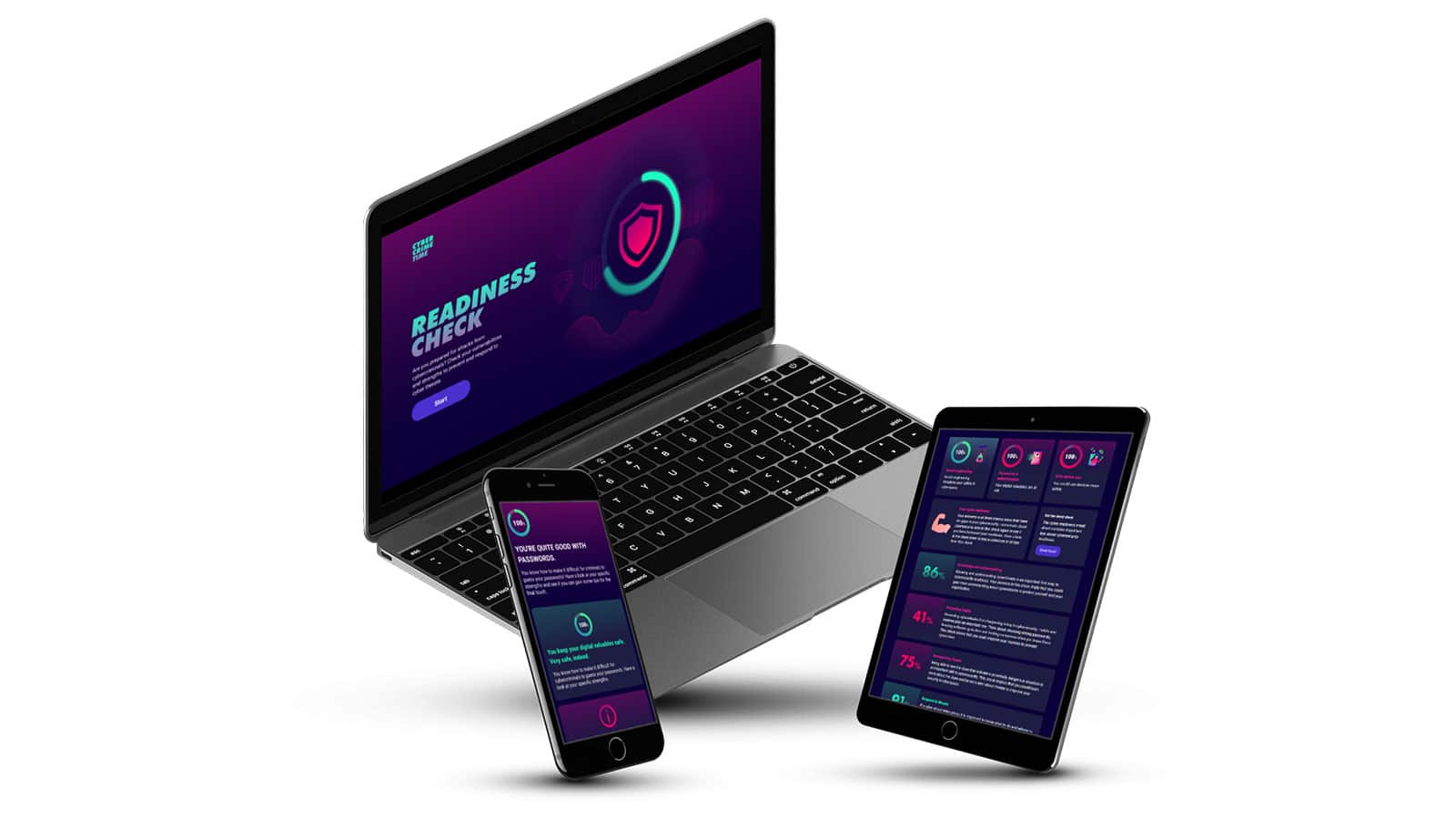
Using the Readiness Check to make learning experiences more customised
The Readiness Check enables companies to build up a highly granular picture of their learners’ current level of knowledge so they can tailor an appropriate response. In all likelihood no two users will ever receive exactly the same feedback when working with the Readiness Check. So, how does it work?
Timo Paul, a senior frontend developer in our content department who played a major role in developing the Readiness Check, explains: “It works by assigning a numeric value to each of various defined learning categories. The numeric values themselves are variable, so they can be specific to the learner. The response yielded by the Check is thus highly customised and can comprise anything from simple feedback to activity or content recommendations all the way through to further training courses or learning nuggets. There are no limitations, and that’s what makes this tool an attractive option for creating customised learning experiences.”
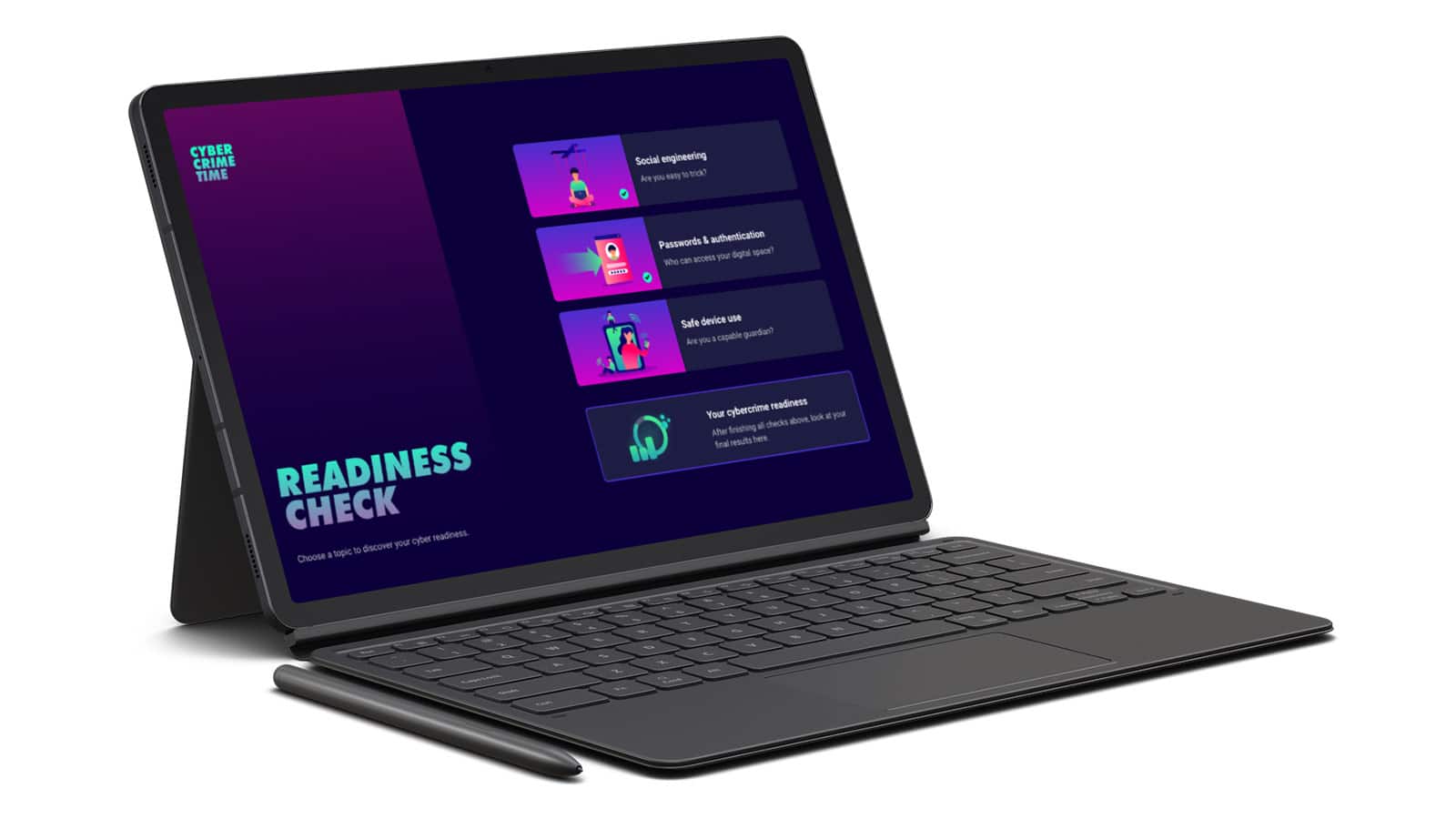
The tool can even be used with very broad learning domains simply by aggregating multiple Readiness Checks into one overall Check, as Timo Paul explains: “It’s a bit like a general knowledge quiz, where you poll the subject’s knowledge in multiple categories and hence arrive at an individual result for each category. The technology behind the system then compiles the results of the individual categories to arrive at an assessment of the subject’s general knowledge.”
It’s all in the weightings
By now, some of you have probably concluded that the Readiness Check uses some form of AI. And you’d be wrong. It uses something even better than AI: humans. The people who configure the Check specify the weightings that lead to the final result. In other words, they determine the numeric values of the individual answers or categories within the Readiness Check, which enables them to make a qualitative assessment of the learner’s existing knowledge.
The overall result is not based solely on the number of correct answers, but also on the weightings that have been assigned in the background. “That’s what’s new about the Check,” Timo Paul explains. “We supply the tool, and then the person responsible for training content works with us to set the tool up so that it meets their needs.”

Cost savings through individualised assignment of learning content
Last year, imc wowed the market with its award-winning “Cyber Crime Time” cyber security awareness game. So, it made sense for the company to integrate this new learning format into its own in-house premium training. And it did this using the Readiness Check. “The development work we did for the Cyber Crime Time Readiness Check was a valuable learning experience for us,” Dr Lohmann says. “It involved developing something in-house and then testing it over and over until we were happy with the result. And that result is the Readiness Check. It’s been a big help for us, and our clients can now benefit from it too. A lot of blood, sweat, tears and time has gone into getting this tool just right, and now it’s ready to go.”

Ready to go!
But the two categories can also be combined to leverage their strengths, Härle explains: “There really are no limits! With an individual learning journey, off-the-shelf content might, for example, be included as learning nuggets. Our objective is to create off-the-shelf content that feels nothing like off-the-shelf. Cyber Crime Time, the Journey, is a prime example for this.”

The Netflix Factor in Self-Directed Learning
Self-directed learning and Netflix have a few things in common! We find out what, how it can be used in companies and where the limitations lie in corporate learning.

Off-the-shelf content has come a long way from being an uncomfortable compromise
Costum or off-the-shelf training content - which should you choose? You should first ask yourself: Is the training need or problem I have very specific? Or is it something that many different people in different industries need training on?

Contact person
I joined the imc newsroom team in 2021. As a journalist my heart beats for content and storytelling.
I’m excited to figure out how e-learing and digitization affect the future of work. My task is to create content to talk about and I’m always looking for trends.
Privately I love to travel and eat Tapas.
Topics: E-Learning Trends, Corporate Social Responsibility, Press and Influencer Relations

Training Digitisation – Leverage knowledge sharing among your people
Here we look at the important topics of knowledge sharing and training digitisation, with tips on how to leverage the experience of your employees to improve performance and future-proof your business.
For many businesses, especially those within the knowledge-based economy, existing employees are their greatest asset. Staff turnover is expensive for any business. Studies show that the direct cost of replacement is over £30,000 on average to replace an employee earning over £25,000 per annum. However, more detrimental is often the indirect cost that comes with losing valuable knowledge and experience - something that is far harder to measure.
Facilitating and encouraging knowledge sharing across your organisation can be an extremely effective way to both enhance productivity within your existing teams and mitigate the brain drain that comes with staff turnover.
While your L&D department can roll out training programmes in a planned and centralised manner, a culture of knowledge sharing and a toolkit that makes it easy means that information can be shared at the speed of need (‘Just in Time Learning’) and when it’s convenient for subject matter experts to do so.

Knowledge Sharing Definition
Knowledge sharing is the exchange of information, skills and experience between individuals or across groups. When expertise is shared by an experienced person, it allows further people to benefit from that experience in order to boost their own performance and that of their peers, potentially strengthening an entire organisation.
Much knowledge sharing occurs naturally and accidentally through day to day interactions and conversations - those ‘water-cooler’ moments that characterise informal learning or tacit knowledge. Of course, the Covid-19 pandemic has caused (or at least accelerated) the transition to a hybrid or fully-remote work environment, making the accidental water-cooler conversation much less likely for many.
That informal kind of knowledge transfer is a social activity that is often hard to describe and organise - it comes with nuance, intuition and the free-flow of ideas.
However, explicit knowledge is something that can be more planned for and organised, so that specific information can be codified and made available to others.
The main attributes of explicit knowledge sharing are:
- Describable - the subject matter expert must be able to clearly articulate the information and experience they want to share
- Visible - the recipient must be made aware that the learning materials exist
- Accessible - the recipient must be able to open and consume the content where and when they need it
- Organised - the recipient must be able to navigate learning materials so that they can be consumed in a structured manner without confusion or information overload
- Complete - the education or training content should fit into a wider organisational context, signpost further related information where needed, and clarify any distinction between self-published, employee-generated content and the more top-down learning materials created by an L&D team.
Knowledge Sharing Benefits
When you have in-house expertise, you’ll want existing and future employees to be able to access it and enhance their own performance as a result. Knowledge sharing benefits can grow exponentially across a large organisation, spawning new ideas and strengthening the collective brain.
With a culture of knowledge sharing and providing the tools for digitising content, along with the structures to support it, a company can gain a great deal of competitive advantage. Some of the many benefits of knowledge sharing include:

If important knowledge is shared frequently and in a well-organised manner, the loss and disruption caused by a key employee leaving is greatly reduced.
Information shared by the leaver can be made available to their peers and / or successor, in addition to the general onboarding and training materials.
While guarding against brain drain is about making the organisation resilient to employee departures by being agile in a reactive situation, succession planning is about looking ahead to (perhaps even scheduling) departures and promotions. This includes the process of knowledge transfer that will need to take place during that transition.
Starting in Spring 2021 during the Covid-19 pandemic, employees voluntarily leaving their jobs en-masse in many countries - most notably the US - was a trend dubbed ‘The Great Resignation’ by organisational psychologist Dr Anthony Klotz.
The pandemic caused employees in many countries to rethink their work-life balance and many countries, including the likes of the UK, Australia and Canada as well as the US, saw resignations increase, in addition to the millions of forced redundancies.
Regardless of Covid-19, millions of ‘baby boomers’ - those born between 1946 and 1964 - are now hitting retirement age. This large cohort of the population holds vast amounts of information and experience to share with their Generation X, Millennial and Gen Z successors.
Two of the great frustrations among business leaders are duplication of effort across teams that wastes resources and a lack of communication that prevents learning from previous mistakes.
With greater insight into what other groups are doing or have done in the past - good and bad, knowledge sharing helps time and resources to be used more effectively.
When individuals hoard information (albeit unintentionally most of the time), trust among peers is diminished.
Providing employees with knowledge building tools, such as the ability to quickly and easily create and share digital training materials, more employees will feel supported by each other and that they are working collaboratively as part of a genuine team.

Employees often feel that they are not being listened to, which can lead to discontent and potentially resignations as a result. Rather than only experience top-down training that can feel disconnected from their real-like working environment, knowledge sharing tools and processes can help employees at every level to create learning materials that help to provide management support and information gathering.
This can then influence subsequent onboarding and training materials created by management and L&D teams, making them more contextually relevant.
The 70:20:10 learning methodology proposes that, on average, 70% of workplace learning is done ‘on the job’, while 20% is done through the sharing of knowledge between peers and only 10% is through formal, top-down onboarding and training.
That 20% part in the middle goes both ways - not only does the recipient benefit from information shared by the expert (making the 70% on the job part feel better supported) but the action of sharing knowledge can actually strengthen even the expert’s understanding of a subject.
Studies such as this one detailed in the Applied Cognitive Psychology journal show that learning by teaching others is extremely effective because it enhances the pathways of knowledge retrieval.

Training Digitisation & Knowledge Sharing Tools
Digitising training makes it possible to store and share information with an unlimited number of employees, even across territories, virtually instantly. A good, modern elearning content authoring tool makes it easy for any of your employees - regardless of their technical skills - to share knowledge digitally.
Such an authoring tool, like imc Express, can immediately benefit colleagues in any location via the cloud, while this form of training digitisation makes more knowledge available for future recruits too.
This is about employee-generated training content, and each person will have their own preferences around the style and media they feel most comfortable using for knowledge sharing.
Therefore, you’ll want to make sure your authoring tool enables content creation and sharing though any combination of:
- Text
- Audio
- Video (including subtitling)
- Images
- Interactive elements
There should be little to no learning curve when it comes to an elearning authoring tool for employee-generated training software. It should be easy to access on any device, easy to use, and make the sharing of materials a fast and simple process.
It should also provide visual elements out of the box to make that training eye-catching and engaging by default so that your people can be proud of the materials they create - without needing to work at it.
For over 20 years, we’ve worked with some of the world’s leading brands, such as Audi, BASF, Sky, Deloitte and Vodafone, supporting their training needs with elearning solutions.
This experience has enabled us to create an elearning toolkit that makes it easy for them to digitise training content and make it accessible across multiple locations, countries and even languages.
If you’d like to learn more about how our solutions could enhance training digitisation and knowledge sharing within your organisation, feel free to contact us for an informal chat about your needs and goals.

Courage to the LMS - also as SME!
Not only big companies should have the courage to go for a Learning Management System (LMS). In our interview Christian Mai from S&G Mercedes Benz, tells about his experiences with rolling out an LMS in a Small and Medium Enterprise (SME).

The big e-learning glossary
WBT, SCORM, Predictive Analytics, Blended Learning - uh, what? The first two articles in this series are a glossary for those who have felt lost in the e-learning jungle of abbreviations and technical terms.

Using Improvisational Theatre for Corporate Learning
Interview with Marlene Konrad, a consultant and trainer specialising in communication, collaboration and change
The curtain is just about to go up. The actors are calming their nerves as the excitement in the audience builds. Just another “normal” day at the theatre. Except there’s no script: anything goes. This is improvisational theatre, and spontaneity is the name of the game.
Improv actors need to be constantly on their toes, ready to pivot and respond to ever-evolving situations. Working together, they juggle ideas, developing the scene as they go along. If one idea falls flat, they move on to a new one without any break in the flow of action.
The skills used by improv actors seem to align closely with what’s expected of a lot of teams in today’s corporate world. In both cases, it’s about navigating uncertainty, constantly adapting to new challenges, trusting in one’s teammates, and working together spontaneously.
If this is true, then surely it’s not too much of a stretch to use improvisational theatre techniques in corporate learning? To find out how this might work, we spoke to Marlene Konrad, a consultant and trainer specialising in communication, collaboration and change.

Change requires a willingness to learn
“For me, learning and change are two inseparable parts of the same thing,” Marlene Konrad explains. “Change in an organisation can succeed only if all employees learn something new and if they learn how to grow and develop. That’s why learning is such a key part of my work.”
Konrad studied theatre and media studies and English language and literature. She completed her practical training at Commha Consulting, where she continues to work as a consultant and trainer.

Marlene Konrad
In her work, Konrad likes to switch things up and try out-of-the ordinary approaches. She is passionate about improv theatre, for example. “Using improvisational theatre, or at least elements of it, as a training method is nothing new. It’s called applied improvisation, and it’s been around for quite a while. But I’ve developed my own personal approach because I’ve been doing improvisational theatre for a long time and have led several improv groups.” Alongside a whole range of improv-inspired projects, Konrad uses improvisational theatre techniques in two main areas.
Agile teams
The salient point here is that improvisational theatre is a team sport. “Improv theatre teams have many characteristics and skills in common with effective teams in work contexts. Hence, we can adapt a lot of improv techniques for team development and collaboration. Improv teams have to remain unfazed by extreme situations. They need to be able to navigate complete uncertainty, for example. And that’s also something that is expected of agile teams in work contexts.”
Reflection
Another key aspect of improv theatre is that it sheds light on things that would otherwise remain hidden: “Improvisation makes intangible things real. That’s why I like to use it as a tool for reflection. Improvised roleplays bring into the open things that are normally difficult to explore, such as communication, conflict, feelings and interpersonal relationships. This is hugely important in feedback training and leadership seminars, for example.”

New Work – new challenges: Tomorrow’s teams need more certainty
For Marlene Konrad, one of the greatest challenges in organisational transformation processes is to embrace flexible thinking. She explains this in terms of companies weaning themselves off rigid processes and workflows while still ensuring that their employees feel safe and secure. “Perhaps you’ve heard of ‘psychological safety’. This is where I foster in a team a sense of safety that comes from the team itself, from the interrelationships and responsibilities between the members of the team,” Konrad explains. “It’s important that this feeling of safety no longer derives from processes because processes can quickly change. So, as well as being flexible, the team needs to work on relationship building.”
Improving this sense of safety within teams is another area where improv theatre techniques can help. To be able to function as a member of an improv team, you have to be open to what’s going on around you and willing to put yourself out there as a person. “You’re thrown into a situation where you need to swing into action quickly because there’s no time to think about ‘what if’. In that situation, you need to have the confidence that you won’t make a fool of yourself if you react spontaneously. That it’s okay to mess up and fail. The art is to ‘fail well’. And that’s something that can be practised using improvisation methods.”

The “Yes, and...” thinking as an innovation booster
Ever been in a meeting and heard an idea dismissed with “yes, but...”? How might that meeting have gone differently if everyone had said, “yes, and...” and simply taken the idea and run with it?
“Yes, and ....” thinking is a key part of improv theatre, and it’s a highly effective technique in innovation processes, as Konrad knows from personal experience: “By saying ‘yes’, I start by accepting what my conversation partner is saying. I consciously avoid following that with ‘but’ because a ‘but’ can close the door to a lot of potentially good ideas. You need to keep that door open and start out by saying yes to everything. Spontaneous improvisation is a good way of explaining this principle.”
Of course, after all those yeses, the team needs to make an intelligent selection and close the meeting. “That’s another aspect that improvisational theatre is great at teaching,” Konrad explains. “When doing a scene, if you keep bouncing from idea to idea to idea, then sooner or later the audience will get bored. Hence the actors need to focus, build coherence and bring the scene to some kind of logical conclusion. By training in that, too, you can learn how to conduct brainstorming sessions and manage innovation processes successfully using the ‘yes, and...’ principle.”

Improv techniques can also be used in digital learning journeys
While taking an entire improvisational theatre performance digital might be a bit of a challenge, the learning methods involved are actually highly transferable to digital learning journeys. The only prerequisite is that all participants meet in an online session with their cameras and microphones on.
Marlene Konrad has already run numerous remote training courses and speed learning sessions using improv theatre methods. “They work really well online. The improv exercises often give rise to a certain synchronicity, or presence, between the participants that enhances the training. And that’s true online, too.”

Examples of learning with the impro method
- Role reflection
- Feedback training
- Innovation/design sprints
Konrad has now developed her improv training technique to the point where she can hold online sessions with more than 20 learners. “It actually works surprisingly well in large groups. For individual roleplays or improv scenes, you can work really effectively in breakout sessions and then reconvene the whole group to reflect and share the learnings.”
Multi-participant digital sessions can be incorporated alongside web-based training and self-learning phases into most learning journeys. That is why our experts recommend that designers consider all format options when creating digital learning journeys. It’s all about having a mix of formats because different learning formats work best with different types of content and offer different advantages. And now: Curtain up!

The Netflix Factor in Self-Directed Learning
Self-directed learning and Netflix have a few things in common! We find out what, how it can be used in companies and where the limitations lie in corporate learning.

The Power of Emotionally Intelligent Brand Training
Emotionality makes it easier for employees to identify with the brand. This identification has a positive effect on motivation and thus directly on daily work. Emotional brand training also generates brand ambassadors from within the company - both internally and externally.

Contact person
I joined the imc newsroom team in 2021. As a journalist my heart beats for content and storytelling.
I’m excited to figure out how e-learing and digitization affect the future of work. My task is to create content to talk about and I’m always looking for trends.
Privately I love to travel and eat Tapas.
Topics: E-Learning Trends, Corporate Social Responsibility, Press and Influencer Relations

A Digital Transformation Mindset for Your Learning Ecosystem
Here we look at the reality of what a digital transformation mindset is within an organisation and how your learning ecosystem is not just an aspect of it, but how it should be the central hub for change.
First of all, we need to clear up a myth. Digital Transformation is NOT about adding technology. It’s about cultural change across an organisation and a fundamental shift in how business is done.
Much like a hammer does not build a house - it’s simply a tool - technology does not make a digital transformation. If you want to take your organisation through a digital transformation programme, you need to shift how your managers and employees think and talk about work.
A digital-led organisation is one looking to find new levels of efficiency, profitability and future-proofing by being open to and adopting technologies that can make these happen. It’s a programme that is initially top-down but that requires buy-in at all levels and that has the goal of empowering employees and customers, so that the implementation is bottom-up.
Prominent IT industry expert Brian Solis defines digital transformation as:
“The realignment of or investment in new technology, business models, and processes to drive value for customers and employees and more effectively compete in an ever-changing digital economy.”
Because digital transformation is a mindset not confined to tech, it is relevant to any sector - even those seen as traditional and steady, such as Law and Accountancy. In fact, it is those sectors that are traditionally slow-moving and that are seen to play it safe where there is often most to gain. Digital transformation can be a powerful competitive advantage where you can leap ahead.

The components of digital transformation
For a large organisation looking at cultural change, where to start can be an overwhelming prospect. It’s important to achieve consensus among your leadership team. Like most IT projects that fail, the issue is rarely down to the technology but rather the communication and implementation process - the resistance that comes from new systems being forced upon a team that was not fully bought-in.
Back in 2018, Forbes estimated that $1.3 Trillion was spent on digital transformation initiatives, with 70% ($900 Billion) of that budget wasted.
Since then, business leaders have become increasingly aware that not what you implement but how you implement it is key to success.
Global technology giant Hitachi break digital transformation down into 6 key components:
- Innovation
- Collaboration
- Experience
- Infrastructure Modernisation
- Operational Excellence
- Information and Insights
By keeping these 6 areas front of mind, you can help to ensure that your ideas for digital transformation amount to much more than buying the latest hardware and software - they’re about broader business goals.
The successful Olympic British Rowing team of the early 2000’s had the mantra:
“Will it make the boat go faster?”
When looking at digital projects, every stakeholder should be asking similar questions: “Will this improve collaboration?”, “Will this increase operational excellence?” etc. But you should also ask questions at the implementation stage, such as “Are we ensuring collaboration, operational excellence etc” before, during and after the roll out of new digital systems.
The Role of your Learning Ecosystem in Digital Transformation
When you think of Learning within the context of Digital Transformation, you might think put the face to face training online right? Use elearning instead of traditional training…
Well, going from face to face to elearning is part of a digital transformation yes, and many organisations were forced to accelerate this process in the midst of the Covid-19 pandemic during 2020 and 2021 in particular.
However, the most powerful contribution that elearning can make within Digital Transformation is in creating the central hub where every area of an organisation can learn about the programme, how it affects their team and their role, and access the latest information about progress.

What is the Learning Ecosystem?
The word ecosystem comes from biology and refers to a specific geography and the complex interactions of all the living things (from large animals to plants and microscopic organisms) between each other and their environment.
Therefore, a learning ecosystem refers to the components of People, Technology, Tools (including Data), Systems and Culture that affect Learning. Some definitions include Strategy as one of the components. However, if you are going to proactively create a learning ecosystem then the Strategy should sit above it and contain your guiding principles. It should define how you are going to create and shape the learning ecosystem.
A learning ecosystem will involve the L&D team of course, the Learning Suite (an LMS, LXP or even better - an integrated solution), and the way data on elearning is collected, processed and shared. Crucially, a learning ecosystem will every learner (ie every person) across the organisation and the collective attitude towards learning.
A digital learning ecosystem, if created and managed well, can embody the entire digital transformation. It involves using a digital-first approach to every aspect of learning and knowledge sharing.
At the centre of this digital learning ecosystem is the learning platform or ‘learning suite’ - the main L&D toolkit for managing and rolling out learning to every member of the organisation.
A modern, branded, engaging Learning Suite will perform two major functions:
Push training out
Push training out to relevant parties as and when required at the time and speed of need. This is a common learning management system (LMS) functionality. It allows HR, L&D and other business leaders sight of training progress so that they can ensure their teams are up to speed with new systems and organisational processes.

Pull employees in
Pull employees into the digital transformation programme by being home to all the current thinking, planning and progress information. Done well, there will be background documents, company vision videos from leaders, cross-departmental data and more.
By making such information available 24/7, every employee can feel that they are on the digital transformation journey with the company, and that there is greater transparency than being told about a programme by email or a one-off memo.
Benefits of a Digital Learning Ecosystem
A great learning ecosystem will be much more than where you go to complete training when you are told to. It will be where employees and managers can go to learn about what their peers are doing in other departments and share ideas, fostering greater team spirit.
Ideas can be shared and found, leading to experience being harnessed and retained, even when talent inevitably leaves from time to time.
Such knowledge sharing can be a powerful tool in ensuring operational excellence, being a meeting place for collaboration and uncovering useful information and insights.
Rather than digital projects happening in silos, signposting them within your learning ecosystem will provide data and insights that enable other teams to learn about what has worked (or not) within the organisation, where integrations may be possible, and where people can communicate and help each other.
In Summary
Peter Drucker suggested that the greatest contribution of management in the 20th Century was the 50-fold increase in productivity among manual workers through managerial practices.
The term ‘digital transformation’ took hold around 2013-14 and although many companies have experienced hiccups and stumbles, it could well have similar impact in the 21st Century. In the knowledge economy, companies who do digital transformation well could bring massive increases in productivity among their knowledge workers.
By placing a well thought-through Learning Ecosystem at its heart, your Digital Transformation could be designed, developed, implemented and leveraged to make your organisation a 21st century leader.

Learning culture nourishes learning ecosystem
“No appointments today – I’m learning.” Is it possible to write that without earning funny looks? Making it possible is a key task for modern companies. Learning and professional development must lose the “necessary evil” or “seminar as a benefit” labels and be anchored as a vital component of corporate culture.

Learning ecosystem: A universe of Learning
To successfully establish a Learning Ecosystem wthin a company-wide LMS, the technical requirements must be right. We reveal which stumbling blocks you better avoid and how employees can be optimally integrated.
Contact person

“Off-the-shelf training content is no longer an uncomfortable compromise”
When is a custom training course money well spent? And when does an off-the-shelf training course make sense?
Digital training solutions continue to gain ground. With the objective of placing learners at the core and inspiring them with real learning experiences, decisions have long been based on factors other than just time and cost.
Yet, to design individual learning paths, you don’t necessarily need custom training content. We spoke to two learning experts, who explain the differences between custom and off-the-shelf training content, and describe what content is best suited for a custom or an off-the-shelf training course design.

Custom vs. off-the-shelf training content – the differences
Custom training content – specifically and exclusively designed to meet a company’s e-learning requirements – is generally created from scratch. Its starting point is a specific need or task, for which a special solution is designed, and an entirely new training course is created.
These solutions are a great choice for companies seeking to cover specialised topics, such as training for their own production areas – where it can be safely assumed that no standardised solution suitable for their needs exists.

Custom Content: Jägermeister Meister Academy
Meanwhile, off-the-shelf training content describes training courses or learning content created independently from any specific customer enquiry which can be used by different companies in a generic form. Thus, this content addresses tasks of a general nature rather than a specific issue or need.
Typical topics almost every company needs to deal with would include information security and data protection. These can be perfectly covered with off-the-shelf training courses, as they reflect regulations and laws applicable to all, rather than company-specific issues.
A clear preference for off-the-shelf training content also exists for compliance trainings, given that the fundamental principles are based on the applicable laws. However, if a company wants to convey their corporate policy in their training course, things get trickier. Stephan Härle, Instructional Designer at imc explains: “Off-the-shelf trainings provide information of a general nature: You must be careful with gifts and may have to contact your Compliance department. Meanwhile, custom training content can offer more detail: In our company, gifts worth X or more must be approved by our Compliance department. It is impossible to include this in off-the-shelf training content because guidelines differ in every organisation.”

Standard Content: Cyber Crime Time
“This should really be the first question to ask from a customer perspective – before deciding whether to use off-the-shelf training content or arrange for custom content design,” Philipp Schossau, also Instructional Designer at imc, explains. “Are my training requirements or issues very specific? Or is this type of training utilised by many different people in various sectors?”
How unique is custom training content?
“First of all, we get together with the customer and carry out a major needs assessment,” Stephan Härle says. “If the right conclusions are drawn at this stage, the training can be designed to fit the target group perfectly. But we can only do that with a custom training. Defining the target group very precisely enables us to find the right approach, make the training exciting for a greater number of learners, and increase the completion rate. Custom really means customised for a specific requirement and tailored to the learners’ needs.”
“It’s like buying an outfit,” Philipp Schossau continues: “If you were to attend a gala dinner, it would be rather difficult to find a suitable mass-produced smoking that fits perfectly. However, if I’m only going out for a nice dinner, without it being a special occasion, then I can buy and wear off-the-shelf outfits that I enjoy wearing.”
Still, even the best store-bought suit cannot compete with a tailored fit, and the same applies to e-learning content for certain target groups. “I understand this issue all too well. I have very short arms, and many things will simply not fit straight off-the-shelf,” Schossau jokes.
We raise the bar for off-the-shelf training content
In the past, off-the-shelf content often seemed somewhat stale. That is changing. This past year, imc has been developing and expanding its off-the-shelf content. The specialist department researches relevant topics in its market. Ideally, the solutions are a match for all customers and across countries. But above all, the latest off-the-shelf training courses aim to feel good, cutting edge and highly motivating.

INFO
- At imc, off-the-shelf training content meets the same high requirements for design and user experience as custom training content.
- T off-the-shelf training courses recently designed by imc are fully responsive, and the relevant training courses can be completed from mobile devices.
- Both categories can be integrated into a learning management system (LMS) or be utilised without an LMS.
Stephan Härle: “We want off-the-shelf content to break free from its poor image. While many reasons speak for custom content, off-the-shelf content need not be an uncomfortable compromise. On the contrary, it can be a perfectly suitable and useful solution that is also enjoyable.”
Naturally, resource investments are significantly lower, given that no further input is needed for the content design. Moreover, ready-made training content is available much faster than a custom solution that needs to be designed first. Of course, costs can play a role in this decision, too. Off-the-shelf content is usually cheaper.
But the two categories can also be combined to leverage their strengths, Härle explains: “There really are no limits! With an individual learning journey, off-the-shelf content might, for example, be included as learning nuggets. Our objective is to create off-the-shelf content that feels nothing like off-the-shelf. Cyber Crime Time, the Journey, is a prime example for this.”

Cyber Crime Time
The Grimme Online Award nomination adds to a long line of awards recognising the serious game Cyber Crime Time. With the Cyber Crime Time learning journey, the creators respond to current developments, and offer extensions like the Phishing Detection Booster.
Companies can purchase Cyber Crime Time as off-the-shelf content. A trial version is available for anyone wanting to play the role of a hacker.
The questions companies should be asking themselves, when deciding whether off-the-shelf content could meet their needs:


The Netflix Factor in Self-Directed Learning
Self-directed learning and Netflix have a few things in common! We find out what, how it can be used in companies and where the limitations lie in corporate learning.

The Power of Emotionally Intelligent Brand Training
Emotionality makes it easier for employees to identify with the brand. This identification has a positive effect on motivation and thus directly on daily work. Emotional brand training also generates brand ambassadors from within the company - both internally and externally.

Contact person
I joined the imc newsroom team in 2021. As a journalist my heart beats for content and storytelling.
I’m excited to figure out how e-learing and digitization affect the future of work. My task is to create content to talk about and I’m always looking for trends.
Privately I love to travel and eat Tapas.
Topics: E-Learning Trends, Corporate Social Responsibility, Press and Influencer Relations

How to Implement Compliance Training Online
Here we look at how to implement compliance training online using a learning suite to automate repetitive tasks, track learner progress and ensure that refresher courses and recertifications are completed successfully.
By leveraging the latest learning technology, your organisation can stay compliant while saving valuable time and money, as well as engaging employees with the training process.
A modern ‘learning suite’ will comprise capabilities as both a learning management system (LMS) and a learning experience platform (LXP). When it comes to mandatory training to stay compliant with legal or industry regulations, the former is most relevant.
So below we look at 5 key capabilities you need in a good LMS for compliance training. We then offer 5 quick tips for making compliance training engaging, as well as effective.

Automate Compliance Training
The imc Learning Suite enables you to define target groups for training courses and book them automatically. Progress is continuously documented from the time of booking, and learners can be reminded by automatic messages to complete these courses within the required period.
An automated refresher training mechanism ensures that the course is repeated regularly, so that the employee always meets all compliance requirements. All status changes are stored throughout the entire process, ensuring that all compliance-relevant activities can be tracked and monitored across the board.
By using personal profile data, new employees can also be automatically trained according to requirements during the onboarding process. The imc Learning Suite also supports maintenance through necessary repeat training and recertification.
All compliance-relevant activities are supported by the system, from the nomination of target groups to the tracking of course progress and the so-called “chasing“, right through to the reporting of training measures.
Keep the above info block but remove ‘the’ to read just ‘Reduce susceptibility to errors’.

Assign Training
The training assignment process describes the formation of target groups for defined compliance requirements and the selection of training measures that must be carried out to meet the requirements.
The imc Learning Suite provides support by defining and selecting target groups via inclusion and exclusion rules. Assignment criteria can for example be courses, user attributes, course types, learning paths, skills, group assignments or job profiles. Target groups can be generated automatically via batch jobs that can be configured as desired or after a manual start.

Learner Tracking
The learner tracking process describes the continuous monitoring of the learning progress of training measures. So you can be sure that you meet the compliance requirements. The imc Learning Suite makes the current status of training measures traceable at any time and facilitates progress control via reports, automatic notifications, and the course progress display.
The current status of the training activities can be graphically displayed in the imc Learning Suite on a reporting dashboard. The reports can be configured individually and offer filter options so that those responsible are always informed about the status and possible need for action. On request, the reports can also be sent to the compliance officers on a regular basis or triggered by predefined events.

Chasing
For training measures that must be carried out due to legal or internal company compliance requirements, there is often a fixed timeframe for successful completion. If such deadlines are not met, this can lead to the employees not being able to perform tasks due to a lack of professional qualifications or not being entitled to perform them due to legal requirements.
To support the successful completion of such training measures, employees are not only informed about the status of their mandatory measures, but are explicitly requested to complete them within the defined period. In the compliance environment, the term “chasing“ has become established for this task. Compliance officers can not only easily create compliance training courses in the Learning Suite user interface, they can also assign validated content to users of predefined target groups.
With just a few clicks, graphically appealing and meaningful reports on compliance status can be activated. In addition to the monitoring and chasing options available via the user interface, the notification module of the imc Learning Suite can be used to define the time intervals at which the distribution groups are to be informed by email about the compliance status of employees.
Refresher Training & Recertification
The recertification workflow controls the fulfilment of compliance requirements for the respective target groups on the basis of a dynamically calculated due date. It also triggers recertification processes either manually or automatically at the optimum time.
The efficient design of the recertification process creates a high level of up-to-date information, relieves those responsible for compliance, and reduces sources of error.
!! See an error in this sentence on the original PDF!!

5 Tips for Engaging Compliance Training
Know your target group
Even though compliance today affects almost all work areas and employees, a training course should always be tailored to the target group for which it is intended. Does the target group need in-depth knowledge about compliance, or is it enough to sensitise them?
Focus on performance and outcome instead of mere information transfer
In every area of compliance there are a multitude of problems and rules. But not every possible scenario is equally relevant. Awareness of specific risk areas and possible measures are more important to the learners than knowledge of all conceivable compliance scenarios. The focus should therefore be on the cases that the target group can actually encounter or that have occurred in the past.
Focus on behaviour change
Simply learning rules by heart causes rejection by many people and rarely fulfils the goal of compliance training. After all, the learners should behave according to the compliance rules and not be able to give a lecture on these rules. The focus of a compliance training course should therefore be on changing behaviour.
Use authentic content with consequences
Examples and concrete cases where the learners can test their knowledge in an application-oriented way are preferable to knowledge queries. It is important that these examples can also be encountered by the target group in everyday work. The more concrete a case study is and the sooner it fits into the target group’s working life, the more interesting it is for the learners. This is the only way to show credible consequences that convey the relevance of the content to the learners.
The format is crucial
Compliance as an often dry perceived topic must be brought to life. Even more than with other topics, an initially boring-looking compulsory training can become a learning experience by using scenario-based approaches and storytelling, gamification elements or interactive elements to bring more life into the training. In search of suitable content? Use our popular standard content or develop content perfectly tailored to your situation together with our content experts.

The Role of Compliance in Digital Learning Transformation
Get to know more about the five benefits of how compliance training can make digital learning transformation a fundamental part of a progressive, digitally-savvy organisation.

Don’t call it compliance!
Compliance training - the term alone is a red flag for many employees. We give some tips how to create an interesting training instead.
Contact person

Tips for Using 2D Maps in e-learning
The many advantages of putting learning content into a map structure
Learning content should be inspiring, if not utterly captivating. Ideally, it should be branded and look cool. And it needs to be engaging for the video gamer generation, without alienating more conventional learners. That’s a lot of boxes for modern learning experiences to tick.
Consequently, many companies and organisations are turning to map-based training. Even so, it’s a fairly new area, and the e-learning applications of maps may not be immediately obvious, despite the ubiquity of Google Maps.
That’s why we have put together this article. It explains the difference between 2D and 3D maps and illustrates the structure and advantages of 2D map-based training.

Differences between 2D and 3D maps
Arguably the most important difference between 2D and 3D maps is the browser performance required. 3D maps are rendered live in the browser, so they require more computing power and a very stable network or internet connection. The upside is that 3D maps allow dynamic perspectives: users can switch perspectives within the map.
A 2D map does not allow dynamic perspectives, but the viewer can create the impression of changing perspective by moving relative to the map. This 2D principle is employed in many strategy games, for example. The map is based on images in which it is not possible to change perspectives. The advantage is that fairly large story/learning worlds can be shown without requiring a lot of browser performance.

2D animation
2D does not necessarily mean static. Within a 2D world, it is possible to have individual elements that are animated and dynamic. This is called 2D animation, and it lends life and vibrancy to 2D maps. It is even possible to integrate 3D graphics into 2D maps.
The introduction: arriving on the map
As with most learning experiences, it’s a good idea to start with an introduction. The introduction can appear or pop up on the map in the form of a chat window or a specially created page that briefly outlines the storyline and subject matter of the training session. It is advantageous here to explicitly tell the learner what the training task will involve, and what their objectives are. The benefit of showing an introduction directly on the map at the outset is that the learner does not need to leave the learning world and therefore does not lose focus.
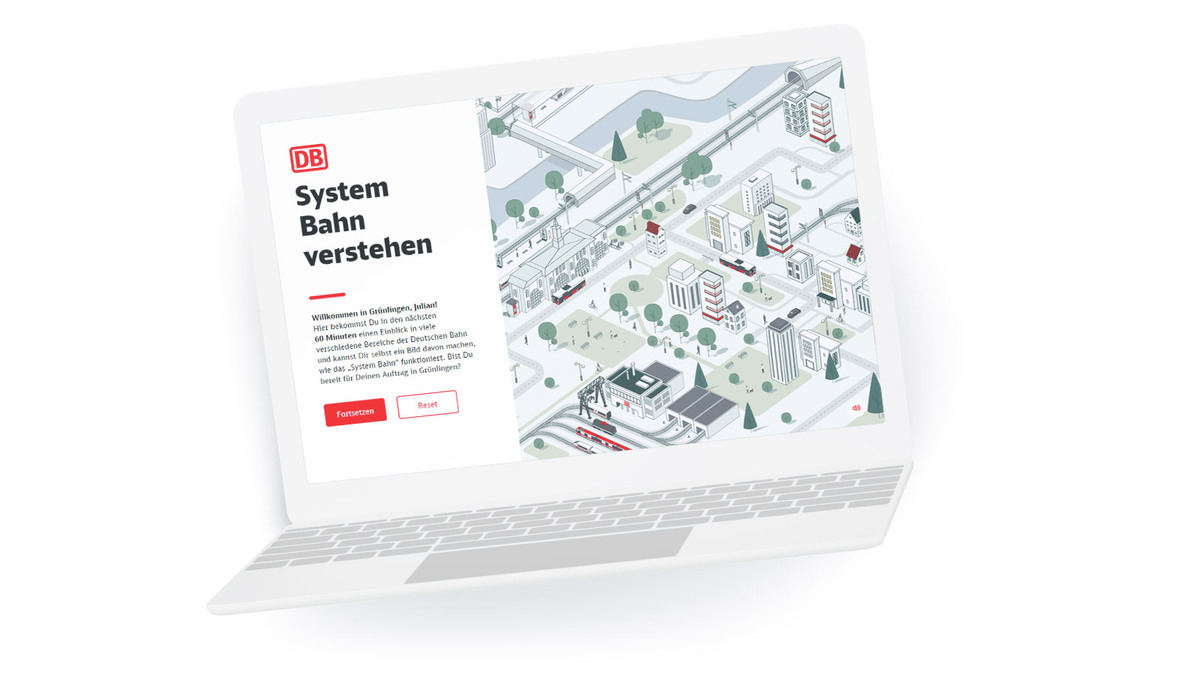
2D Map Training Deutsche Bahn
The main narrative: read the map
It is vital that the main part of the session is self-explanatory. This means the map must be intuitive to use. A certain degree of in-map guidance can be achieved by unlocking individual tasks step by step. That way, learners intuitively know the correct task order, without having to be explicitly told. Crucially, this approach allows learners to discover the learning content for themselves, i.e., exploratively. The navigation leads via the 2D map to various locations that the learner can ‘visit’. An example would be where the map shows a building that the learner can click on and enter in order to progress to the next task or access a learning nugget.
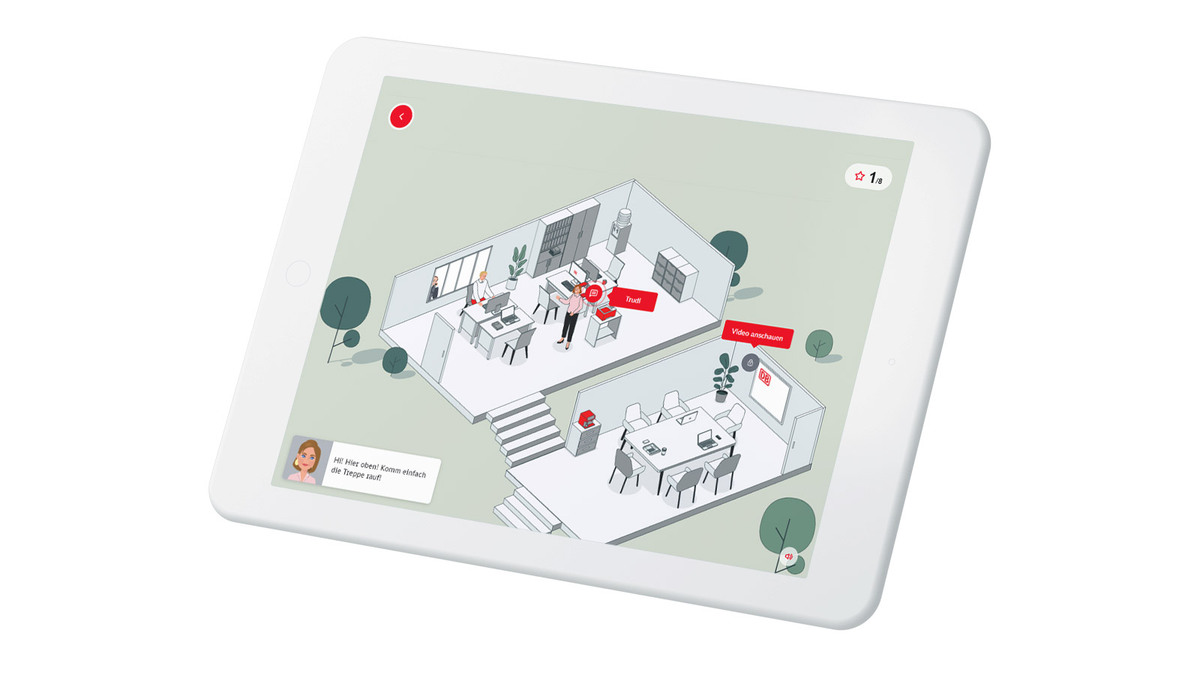
2D Map-Training Deutsche Bahn
Interstitial and achievement screens can be used to lend further structure to the main narrative by appearing as pop-ups overlaying the map. They can provide orientation by showing learners their next tasks, highlighting their progress, or making them aware of further options. The whole learning experience can be made even clearer by adding jump labels to individual locations on the map. These can be used to help the learner navigate from tasks to their associated learning content.
GOOD TO KNOW
Learners should not need to leave the map (the learning world) at any point. Everything they need in order to achieve their objectives should be contained within the map. This can be achieved, for example, by using chat windows that open directly on the map, or by showing learning nuggets, content items and hints as overlays on the map.
The conclusion: leave the map
In 2D maps, just as in other learning settings, it is important to clearly mark the conclusion of learning units and tasks so that learners know they have successfully completed the section in question or indeed the entire training session. There are many different ways of doing this. The key is to ensure the method chosen fits with the training session’s overall storyline. For example, you can use a list of checkpoints which is then displayed at the end with all tasks checked off. Or you can show a notification in the chat window.
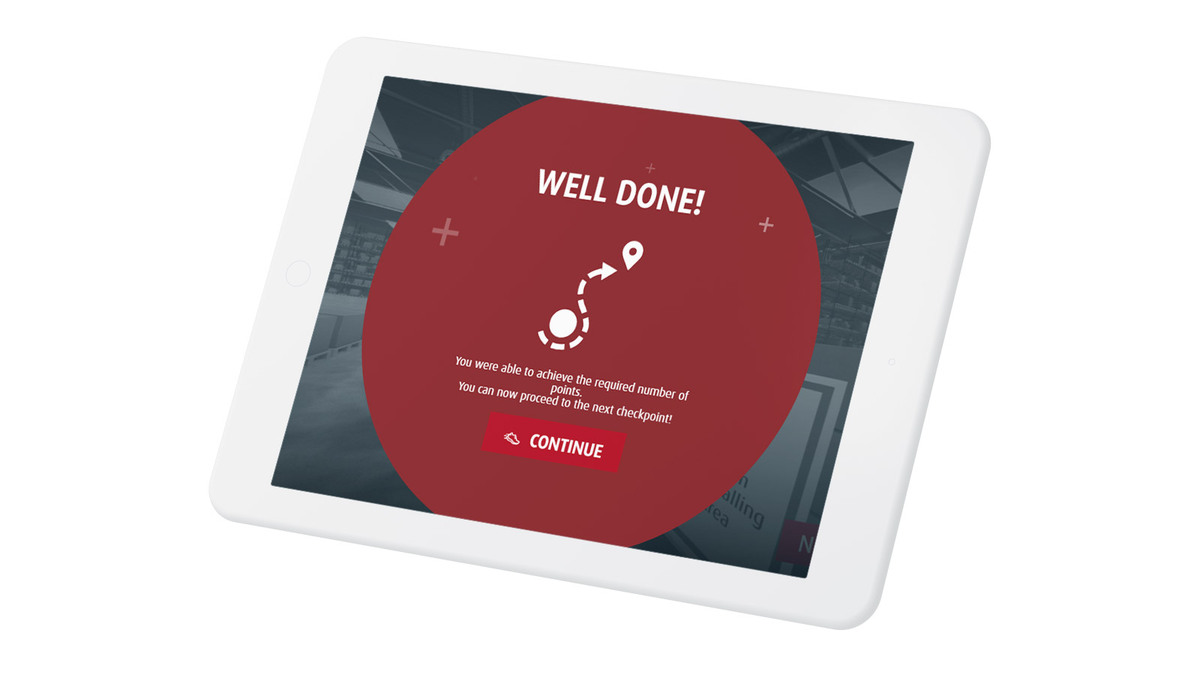
Success message at the end of a training session
Questions?
Can a map-based training session also be short?
To retain the map’s explorative dimension while at the same time creating a training session that can be completed within a short space of time, you can reduce the amount of learning content, streamline the user experience, or confine exploration strictly to key locations on the map. The main thing is to maintain excitement while keeping the learning purposeful.
How gamified can a map-based training session be?
The primary focus must be on the learner experience, so the map should not contain any unnecessary actions or locations.
Surely map-based training sessions are very labour-intensive to produce?
Not necessarily. The total overhead can actually be relatively low, as the world created by a 2D map makes a relatively large contribution to creating an exciting learning experience. It is possible to reduce the design overhead that goes into learning nuggets/subpages by integrating them into a 2D map.
But isn’t that really expensive?
The 2D map format does not necessarily require more design work by our experts, so it is a very good alternative to 3D maps, even for limited budgets.
What are the other advantages over 3D maps?
Good performance, low overhead, faster page loading.

Rapid Content Development
We want things now: fast food, coffee to go, messenger services, online shopping … we no longer have time. Companies have also clocked onto this trend, and want to stay up to date with their training courses.

Gamification takes corporate learning to a new level
The fact that Game Based Learning works as a motivational booster for e-learning is already rooted in childhood. We have summarized the most common types of games and practical examples for you.

Contact person
I joined the imc newsroom team in 2021. As a journalist my heart beats for content and storytelling.
I’m excited to figure out how e-learing and digitization affect the future of work. My task is to create content to talk about and I’m always looking for trends.
Privately I love to travel and eat Tapas.
Topics: E-Learning Trends, Corporate Social Responsibility, Press and Influencer Relations

